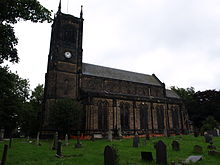Holy Trinity Church, Lenton
52°56′54″N 01°10′35″W / 52.94833°N 1.17639°W
| Holy Trinity, Lenton | |
|---|---|
 | |
 | |
| Denomination | Church of England |
| Churchmanship | Evangelical |
| Website | www.lentonparish.org.uk |
| History | |
| Dedication | Holy Trinity |
| Administration | |
| Province | York |
| Diocese | Southwell and Nottingham |
| Clergy | |
| Vicar(s) | Revd Dr Megan Smith |
Holy Trinity Church, Lenton is a parish church in the Church of England.
The church is Grade II* listed by the Department for Culture, Media & Sport as it is a particularly significant building of more than local interest.
History
Holy Trinity was designed by the architect Henry Isaac Stevens and opened in 1842. It was consecrated on 6 October 1842 by the Lord Bishop of Lincoln (the Right Reverend John Jackson D.D.).
The architectural style is early English. Built in stone with a high pitched roof, it consists of a nave with clerestory, aisles to north and south, a chancel, vestry, organ-chamber, and a west end pinnacled tower.
Its dimensions are 123 feet long and 57 feet wide. When opened it had seating for 660 people.
Features
Holy Trinity is famous for its twelfth century font which was originally built for Lenton Priory and was given to the church by Severus William Lynam Stretton in 1842.
Memorials
- Albert Ball on the north wall. Captain in the Royal Flying Corps who was awarded the Victoria Cross.
List of incumbents
- George Brown MA 1840 - 1886
- Percy Edward Smith MA 1886 - 1893
- Allan Hunter Watts 1893 - 1917
- Felix Asher BD 1917 - 1922
- W. Aden Wright 1922 - 1928
- Rainald J.R. Skipper, CF, 1929 - 1954 (died in the pulpit of Holy Trinity Church, Trinity Square)
- G. Hill (killed in a bicycle accident)
- R.P. Neil MA, 1957 - 1962
- L.L. Abbott, 1963 - 1967
- R.G. Dunford, 1967 - 1980
- David Williams MA, 1981 - 1987
- W Robert Lovatt MA, 1994 - 2004
- Martin Kirkbride,
- Megan Smith, 2012 -
Clock and Bells
An eight-day church clock was built in 1844 by Samuel Holland of Barker Gate, Nottingham. It was 3ft 4in wide and 3ft 6in high, with a dead beat escapement.[1]
The tower has a set of eight bells. The church was originally only provided with one bell, but five more were added in 1856. In 1902, two more bells were added, given by the brothers Frederick Ball and Albert Ball. The latter was the father of the First War War ace Albert Ball.
Organ
An organ was installed at the opening of the church in 1847, and was moved and enlarged by Charles Lloyd in 1870. A new organ by Brindley & Foster replaced this in 1906.
Organists
- Mrs. Cooper 1846 -
- Fred Harvey 1883-1919
- Vernon Sydney Read 1919 – 1922 then organist of St. Mary's Church, Nottingham
- Dennis Marriot ???? - 1938 then organist St. Mary's Church, Wollaton Park
- Charles Pickard 1938(?)-1951 then organist St. Andrew's Church, Nottingham
- W. Harry Bland 1951 - 1982 ?
External links
Sources
- The Buildings of England, Nottinghamshire. Nikolaus Pevsner
- ^ "Lenton New Church Clock". Nottingham Review. England. 16 February 1844. Retrieved 4 December 2016 – via British Newspaper Archive.
{{cite news}}: Unknown parameter|subscription=ignored (|url-access=suggested) (help)
